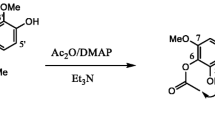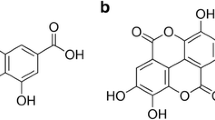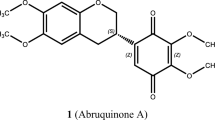Abstract
The search for new therapeutic agents from natural sources has been a constant for the treatment of diseases such as leishmaniasis. Herein, in vitro and in vivo pharmacological activities of pure major phenolic constituents (caffeic acid, chlorogenic acid, ferulic acid, quercetin, and rosmarinic acid) from Pluchea carolinensis against Leishmania amazonensis are presented. Pure compounds showed inhibitory activity against promastigotes (IC50 = 0.2–0.9 μg/mL) and intracellular amastigotes (IC50 = 1.3–2.9 μg/mL). Four of them were selected after testing against macrophages of BALB/c mice: caffeic acid, ferulic acid, quercetin, and rosmarinic acid, with selective indices of 11, 17, 10, and 20, respectively. Ferulic acid, rosmarinic acid, and caffeic acid controlled lesion size development and parasite burden in footpads from BALB/c experimentally infected mice, after five injections of compounds by intralesional route at 30 mg/kg every 4 days. Pure compounds from P. carolinensis demonstrated antileishmanial properties.



Similar content being viewed by others
Abbreviations
- DMSO:
-
Dimethyl sulfoxide
- HFBS:
-
Heat-inactivated fetal bovine serum
- IC50 :
-
Concentration at which inhibition of the activity was 50 %
- MTT:
-
3-[4,5-Dimethylthiazol-2-yl]-2,5-diphenyltetrazolium bromide
- PBS:
-
Phosphate-buffered saline
- p.i.:
-
Post-infection
- SD:
-
Standard deviation
- SI:
-
Selectivity indices
- TDR:
-
Tropical Diseases Research
- WHO:
-
World Health Organization
References
Alkawajah AM, Larbi E (1997) Treatment of cutaneous leishmaniasis with antimony: intramuscular versus intralesional administration. Ann Trop Med Parasitol 91:899–905
Aponte JC, Yang H, Vaisberg AJ, Castillo D, Málaga E, Verástegui M, Casson LK, Stivers N, Bates PJ, Rojas R, Fernandez I, Lewis WH, Sarasara C, Sauvain M, Gilman RH, Hammond GB (2009) Cytotoxic and anti-infective sesquiterpenes present in Plagiochila disticha (Plagiochilaceae) and Ambrosia peruviana (Asteraceae). Planta Med 75:1–3
Berger I, Passreiter CM, Cáceres A, Kubelka W (2001) Antiprotozoal activity of Neurolaena lobata. Phytother Res 15:327–330
Buffet PA, Sulahian A, Garin YJ, Nassar N, Derouin F (1995) Culture Microtitration a sensitive method for quantifying Leishmania infantum in tissues of infected mice. Antimicrob Agents Chemother 39:2167–2168
Bañuls AL, Bastien P, Pomares C, Arevalo J, Fisa R, Hide M (2011) Clinical pleiomorphism in human leishmaniases, with special mention of asymptomatic infection. Clin Microbiol Infect 17:1451–1461
Cabanillas BJ, Le Lamer AC, Castillo D, Arevalo J, Rojas R, Odonne G, Bourdy G, Moukarzel B, Sauvain M, Fabre N (2010) Caffeic acid esters and lignans from Piper sanguineispicum. J Nat Prod 73:1884–1890
Caio TSE, Lima MD, Kaplan MAC, Nazareth MM, Rossi-Bergmann B (1999) Selective effect of 2’,6’-dihydroxy-4’methoxychalcone isolated from Piper aduncum on Leishmania amazonensis. Antimicrobial Agents Chemother 43:1234–1241
Carneiro S, Carvalho F, Santana L, Sousa A, Neto J, Chaves M (2012) The cytotoxic and antileishmanial activity of extracts and fractions of leaves and fruits of Azadirachta indica (A Juss.). Biol Res 45:111–116
Chan-Bacab MJ, Peña-Rodríguez MP (2001) Plant natural products with leishmanicidal activity. Nat Prod Rep 18:674–688
Chen M, Christensen SB, Theander TG, Kharazmi A (1994) Antileishmanial activity of licochalcone A in mice infected with Leishmania major and in hamsters infected with Leishmania donovani. Antimicrob Agents Chemother 38:1339–1344
El-Sayed M, Anwar AE (2010) Intralesional sodium stibogluconate alone or its combination with either intramuscular sodium stibogluconate or oral ketoconazole in the treatment of localized cutaneous leishmaniasis: a comparative study. J Eur Acad Dermatol Venereol 24:335–340
Fatope MO, Nair RS, Marwah RG, Al-Nadhiri HHS (2004) New sesquiterpenes from Pluchea Arabica. J Nat Prod 67:1925–1928
Fonseca-Silva F, Inacio JD, Canto-Cavalheiro MM, Almeida-Amaral EE (2011) Reactive oxygen species production and mitochondrial dysfunction contribute to quercetin induced death in Leishmania amazonensis. PLoS One 6:e14666
Fournet A, Barrios AA, Muñoz V (1994) Leishmanicidal and trypanocidal activities of Bolivian medicinal plants. J Ethnopharmacol 41:19–37
Fournet A, Ferreira ME, Rojas A, Torres S, Fuentes S, Nakayama H (1996) In vivo efficacy of oral and intralesional administration of 2-substituted quinolines in experimental treatment of New World cutaneous leishmaniasis caused by Leishmania amazonensis. Antimicrob Agents Chemother 40:2447–2451
García M, Monzote L, Scull R, Herrera P (2012) Activity of Cuban plants extracts against Leishmania amazonensis. ISRN Pharmacology 2012:1–7
García M, Perera WH, Scull R, Monzote L (2011) Antileishmanial assessment of leaf extracts from Pluchea carolinensis, Pluchea odorata and Pluchea rosea.Asian Pacific. J Trop Med 4:836–840
Inocencio R, Vermeersch M, Deschacht M, Hendrick S, Assche T, Cos P, Maes L (2011) In vitro and in vivo prophylactic and curative activity of the triterpene saponin PX-6518 against cutaneous leishmaniasis. J Antimicrob Chemother 66:350–353
Kedzierski L, Sakthianandeswaren A, Curtis JM, Andrews PC, Junk PC, Kedzierka K (2009) Leishmaniasis: current treatment and prospect for new drugs and vaccines. Curr Med Chem 16:599–614
Kim H, Lee J, Lee J, Park Y, Yoon T (2008) Rosmarinic acid down-regulates the LPS-indiced production of monocyte chemoattractant protein-1 (MCP-1) and macrophage inflammatory protein-1α (MIP-1α) via the MAPK pathway in bone-marrow derived dendritic cells. Mol Cells 26:583–589
Kulkarni MM, Reddy N, Gude T, McGwire BS (2013) Voriconazole suppresses the growth of Leishmania species in vitro. Parasitol Res 112(5):2095–2099
Locher CP, Witvrouw M, deBethune MP, Burch MT, Mower HF, Davis H, Lasure A, Pauwels R, deClercq E, Vlietinck AJ (1996) Antiviral activity of Hawaiian medicinal plants against human immunodeficiency virus type-1 (HIV-1). Phytomed 2:259–264
Mishra J, Saxena A, Singh S (2007) Chemotherapy of leishmanisasis: past, present and future. Curr Med Chem 14:1153–1169
Monzote L, Montalvo AM, Scull R, Miranda M, Abreu J (2007) Activity, toxicity and analysis of resistance of essential oil from Chenopodium ambrosioides after intraperitoneal, oral and intralesional administration in BALB/c mice infected with Leishmania amazonensis: a preliminary study. Biomed Pharmacother 61:148–153
Murray HW (2000) Treatment of visceral leishmaniasis (kala-azar): a decade of progress and future approaches. Int J Infect Dis 4:158–177
Muzitano MF, Tinoco LW, Guette C, Kaiser CR, Rossi-Bergmann B, Costa SS (2006) The antileishmanial activity assessment of unusual flavonoids from Kalanchoe pinnata. Phytochem 67:2071–2077
Nakayama H, Loiseau PM, Bories C, Torres S, Schinini A, Serna E, Rojas de Arias A, Fakhfakh MA, Franck X, Figadère B, Hocquemiller R, Fournet A (2005) Efficacy of orally administered 2-substituted quinolines in experimental murine cutaneous and visceral leishmaniases. Antimicrob Agents Chemother 49:4950–4956
Passero LF, Bonfim-Melo A, Corbett CE, Laurenti MD, Toyama MH, de Toyama DO, Romoff P, Fávero OA, dos Grecco SS, Zalewsky CA, Lago JH (2011) Anti-leishmanial effects of purified compounds from aerial parts of Baccharis uncinella C. DC. (Asteraceae). Parasitol Res 108:529–536
Perera W (2012) Isolation and identification of antioxidant phytochemicals from Cuban species of the genera Erythroxylum P. Browne and Pluchea Cass [PhD thesis]. Liege, Belgium: University of Liege, 2012: p 186
Pink R, Hudson A, Mouriés MA, Bendig M (2005) Opportunities and challenges in antiparasitic drug discovery. Nature Rev Drug Discov 4:727–740
Rocha LG, Almeida J, Macedo RO, Barbosa-Filho JM (2005) A review of natural products with antileishmanial activity. Phytomed 12:514–535
Sales D, Silva AL, de Almeida F, de Almeida I, do Socorro M, de Araujo RM (2012) Conventional therapy and promising plant-derived compounds against trypanosomatid parasites. Front Microbiol 3:1–10
Salmanpour R, Razmavar MR, Abtahi N (2006) Comparison of intralesional meglumine antimoniate, cryotherapy and their combination in the treatment of cutaneous leishmaniasis. Int J Dermatol 45:1115–1116
Sharma U, Sing S (2008) Insect vectors of Leishmania: distribution, physiology and their control. J Vector Borne Dis 45:255–272
Sladowski D, Steer SJ, Clothier RH, Balls M (1993) An improve MTT assay. J Immunol Methods 157:203–207
Soong L (2012) Subversion and utilization of host innate defense by Leishmania amazonensis. Front Immunol 3:1–7
Valadares DG, Duarte MC, Ramírez L, Chávez-Fumagalli MA, Lage PS, Martins VT, Costa LE, Ribeiro TG, Régis WCB, Soto M, Fernandes AP, Tavares CAP, Coelho EAF (2012) Therapeutic efficacy induced by the oral administration of Agaricus blazei Murill against Leishmania amazonensis. Parasitol Res 111(4):1807–1816
Vendrametto MC, Oliveira A, Nakamura CV, Prado B, Garcia DA, Ueda-Nakamura T (2010) Evaluation of antileishmanial activity of eupomatenoid-5, a compound isolated from leaves of Piper regnellii var. pallescens. Parasitol Int 59:154–158
Yardley V, Croft SL (1997) Activity of liposomal amphotericin B against experimental cutaneous leishmaniasis. Antimicrob Agents Chemother 41:752–756
Conflict of interest
The authors declare that they have no conflict of interest.
Author information
Authors and Affiliations
Corresponding author
Rights and permissions
About this article
Cite this article
Montrieux, E., Perera, W.H., García, M. et al. In vitro and in vivo activity of major constituents from Pluchea carolinensis against Leishmania amazonensis . Parasitol Res 113, 2925–2932 (2014). https://doi.org/10.1007/s00436-014-3954-1
Received:
Accepted:
Published:
Issue Date:
DOI: https://doi.org/10.1007/s00436-014-3954-1




